Agronomy Update
Jun 16, 2025
2025 Upper Missouri Valley Fair
June seems to always come and go in a hurry. As I write this, our agronomy team is busy sending out crop protection products, scouting fields, making recommendations, gearing up for summer meeting season, and putting the final preparations in place before bin building season.On the farm it’s chaos as well. Sprayers are active, grain is marketed, and cattle are being branded and turned out, but many of the youth of Williams and McKenzie Counties are busy putting the final bows on their 4-H projects for county fairs (meanwhile our friends on the Montana side of the line still have a little bit of time).
I’ve always loved county fair season. It’s exciting to be around youngsters that are so passionate about agriculture. Our Williston Agronomy intern this year, Shaun Branham, was one of the first 4-H exhibitors I had the pleasure of meeting when I moved here 5 years ago. Shaun has been the model of what we hope to build here in the future: a strong pipeline of young adults passionate about helping the producers of our trade area be successful.
Many of our staff, including myself, will be around the county fairs enjoying the sights, sounds, and flavors of the summer. Grab us and say hello if you catch us around the fairgrounds this year and good luck to all of our patrons of today and tomorrow!
Watch On the Horizon from June 13, 2025 where I sit down with youth from Williams and McKenzie Counties to talk about their upcoming fairs!
Levi Hall
COO & Grain Division Manager
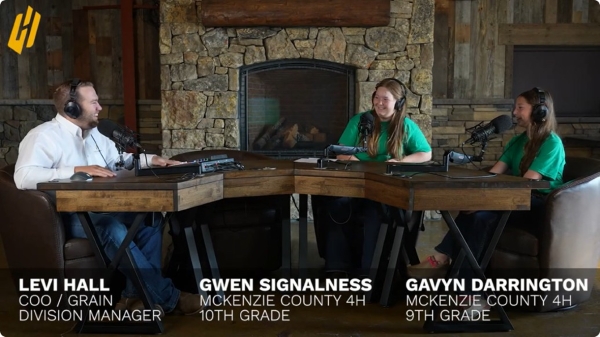
Ascochyta Blight Management
It might seem a little early to be discussing foliar fungicide applications, but with such an early seeded crop and the recent rain I thought it would be a good idea to get ahead of the game. Ascochyta blight is a common foliar disease that affects peas, lentils, and chickpeas in our region. As the crop approaches flowering, it is worth assessing the risk of Ascochyta. This disease not only reduces yield but can also impact grain quality through seed staining. Infected seed may also serve as a source of the pathogen in future seasons, meaning disease presence in 2025 could lead to elevated risk in 2026.The pathogens that cause Ascochyta are unique to each crop, and susceptibility also varies. Chickpeas are highly susceptible, followed by peas, then lentils. Although breeding has resulted in some pea and lentil with partial tolerance or moderate resistance respectively, even the most resistant chickpea varieties remain highly vulnerable. Therefore, fungicide timing and selection must be tailored to the specific crop and pathogen, considering differences in sensitivity and known resistance patterns.
Field Peas
In field peas, Ascochyta blight is caused by three fungal pathogens: Ascochyta pisi, Didymella pinodes, and Didymella pinodella. To make things more confusing it is also sometimes referred to as Mycosphaerella blight. A survey conducted by NDSU researchers from 2017 to 2020 identified D. pinodes as the dominant species, comprising 73% of isolates, with A. pisi making up the remaining 27%.D. pinodella was not found in the survey.
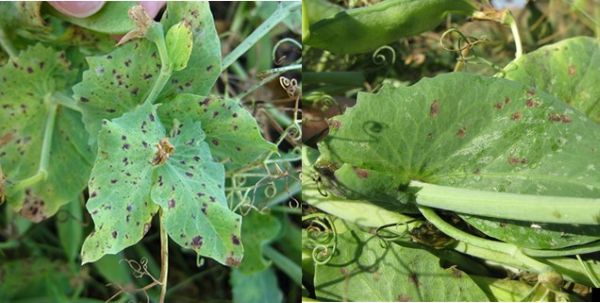
Mycosphaerella/Ascochyta blight symptoms caused by D. pinodes (left) and D. pisi (right). Saskatchewan Pulse Growers, Dr. Mary Burrows
Unfortunately, D. pinodes is now resistant to Group 11 fungicides, also known as QoIs, which include products such as Quadris and Evito.
Although these products are still labeled for use on Ascochyta in field peas, they would not be effective in North Dakota due to the resistant pathogen population. Products in Group 3 or Group 7 remain effective, and the North Dakota Field Crop Plant Disease Management Guide provides a complete list of labeled products.
Field pea should be scouted at the late vegetative growth stage (V8) through early bloom (R2). If disease stays in the lower third of the canopy yield losses are generally minimal but if it is moving up in the canopy a fungicide may be warranted. Weather conditions will dictate disease risk and a fungicide application decision guide is attached. Refer to the Pea Disease Diagnostic series to help correctly identify symptoms. Fungicide should be applied at early flowering, when most plants in the field have one open flower. Coverage of lower canopy leaves is critical, as fungicides have limited mobility within the plant. Using high water volumes (at least 15 gallons per acre) and a deposition aid can help improve penetration into dense canopies.
Lentil
Ascochyta of lentil is caused by Ascochyta lentis. Unlike pea, QoI fungicides are still effective against this pathogen. Susceptibility varies by variety, with many of the modern varieties grown in Canada being described as moderately resistant. The medium green varieties commonly grown in our area, Richlea and Avondale, do not have resistance to Ascochyta. In fact resistance of Richlea is rated as “very poor” (Sask Pulse). CDC Viceroy, a small green variety grown in our area, is rated as moderately resistant.The time to scout for symptoms is similar to field pea, that late vegetative growth stage prior to flowering. The Lentil Disease Diagnostic Series can help diagnose symptoms. The optimal time to control foliar disease in lentil is from the 10 to 12 node stage up until early flowering. We want to be able to get the fungicide down into the lower canopy so ideally before canopy closure.
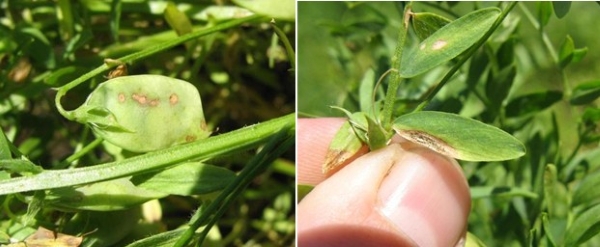
Ascochyta blight of lentil. Dr. Mary Burrows, Montana State University
Growers commonly use Headline or Quadris, both group 11/QoI fungicides, to manage Ascochyta in lentils. However, Anthracnose, another important foliar disease of lentil, has become resistant to the QoI fungicide group in Saskatchewan. For our Northern neighbors, Anthracnose is the most important foliar disease since they grow Ascochyta resistant varieties. Given that Anthracnose travels by seed, it is possible that we have imported this issue to North Dakota.Unfortunately, there are currently no research efforts to determine if that is the case.
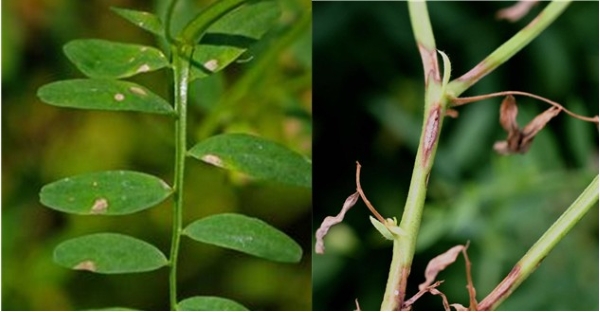
Anthracnose of lentil. Dr. Michael Wunsch (left) and Kurt Lundbeck (right)
In the absence of resistance, Group 11 fungicides remain the most effective option for managing Anthracnose. Products such as Priaxor and Delaro combine a Group 11 active ingredient with either a Group 7 or Group 3 active ingredient and can help manage both Ascochyta and Anthracnose. These dual-mode of action products also play an important role in slowing the development of resistance to Group 11 fungicides, which, based on patterns seen in peas and chickpeas, appears almost inevitable.
Group M, or multi-site fungicides like Bravo and generic versions such as Praiz, have also demonstrated efficacy against both Ascochyta and Anthracnose. However, as a contact fungicide, it relies on good canopy coverage to be effective. Greenhouse research conducted by Agriculture and Agri-Food Canada in 2021 evaluated disease severity across both sensitive and resistant Anthracnose populations. The results highlighted poor performance of standalone QoI fungicides due to resistance, and the importance of multi-site or mixed-mode products. Product names referenced in this research reflect those used in Canada and may differ from U.S. formulations. Dyax, for example, shares the same active ingredients as Priaxor, while Miravis Neo is not currently labeled for lentil in the United States.
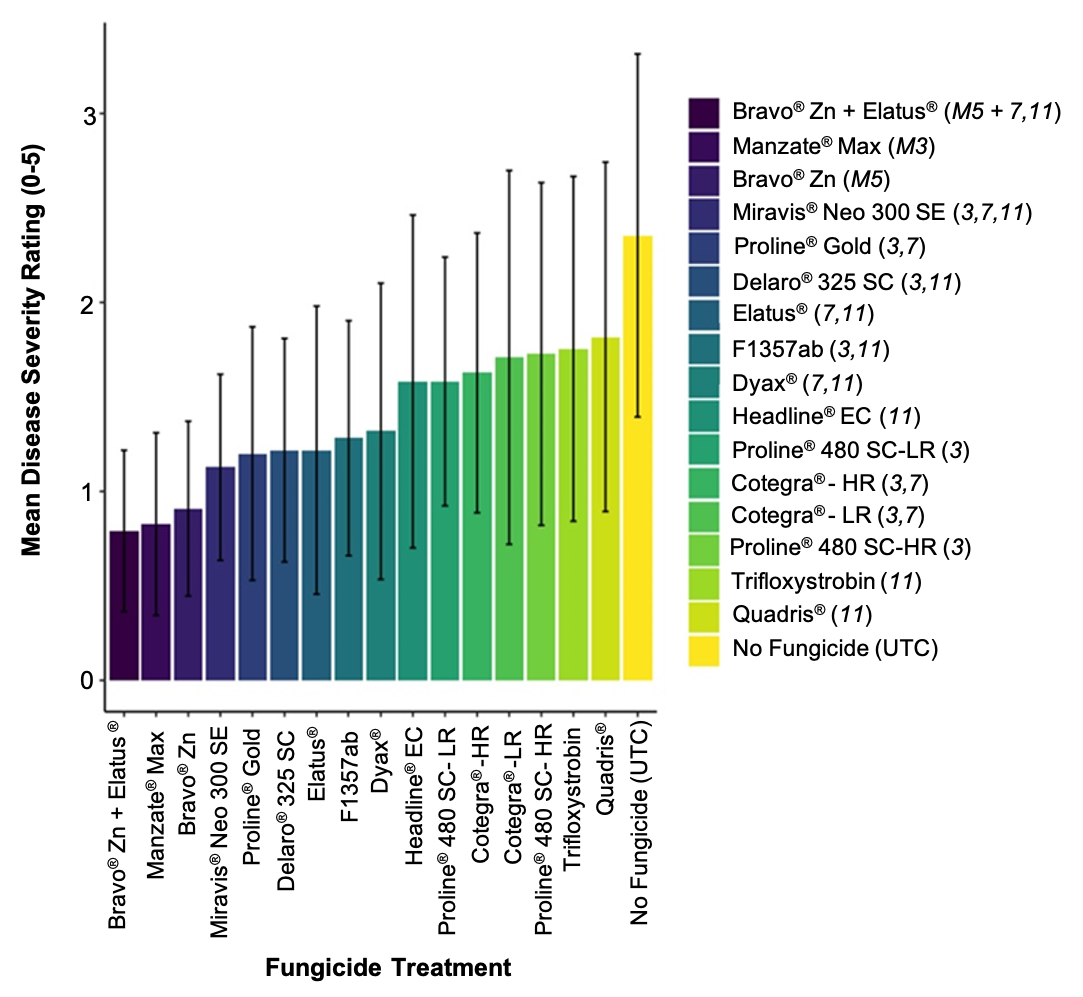
Average Anthracnose disease severity by fungicide treatment. Taller bars and yellow color indicate higher levels of disease. Blue and purple colors and lower bars indicate better disease control. Dr. Michelle Hubbard, AAFC
Chickpea
Ascochyta of chickpea is caused by the pathogen Ascochyta rabiei and this is a different animal from foliar diseases of pea and lentil. Plan for at least one fungicide application, and in a wet year you could apply up to three. In North Dakota this pathogen is resistant to Group 11 fungicides. Research by Dr. Michael Wunsch indicates diminished control from the product Priaxor since 2020, suggesting that this Group 7 fungicide (Fluxapyroxad) will not be effective. Another Group 7, Endura (Boscalid), has also performed poorly.Current control recommendations focus on Group 3 fungicides, including Proline and Provysol, or Group 3/7 combination products such as Miravis Top. Tank mixing Proline with Bravo or a generic chlorothalonil provides excellent control under high disease pressure. Given the history of rapid fungicide resistance development in this pathogen, incorporating a multi-site fungicide such as Bravo may help preserve the effectiveness of remaining products. It is important to include a variety of fungicide groups in the rotation to avoid repeated applications of Group 3 alone.
Because chickpea Ascochyta is so aggressive, scouting and treatment must begin earlier than in peas or lentils. Scouting should start at the seedling stage, and the picture below shows characteristic symptoms. You can also refer to the Chickpea Disease Diagnostic Guide to compare and contrast against other diseases which affect chickpea.
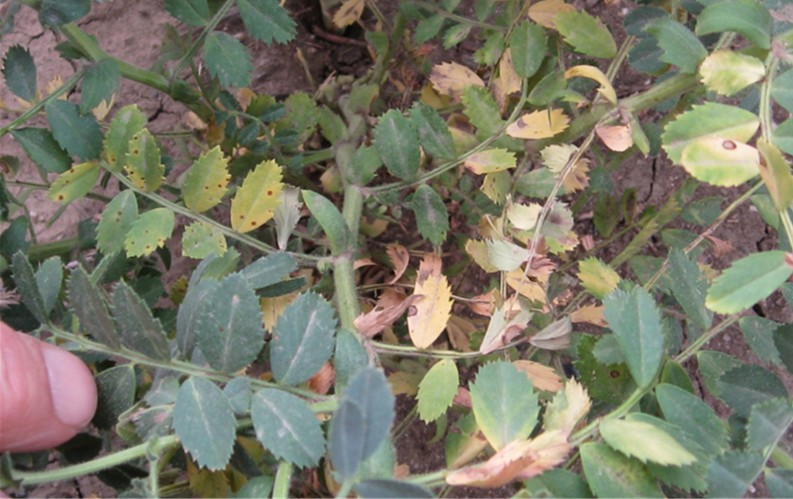
Sabine Banniza, CDC, University of Saskatchewan
Saskatchewan Pulse Growers recommend making the first fungicide application at the 7 to 10 node stage. This timing can coincide with grass herbicide applications for efficiency. I followed this approach last season, and with our wet spring, I was pleased with the level of control achieved. Several fields experienced high Ascochyta pressure, and without early applications, we would have seen significantly more stem and pod infections, leading to yield and quality losses.
Fungicides typically provide 10 to 14 days of protection, so follow-up applications should be based on rainfall and disease pressure. This is not a disease to ignore—consistent scouting is essential.
Integrated Foliar Disease Management
Ascochyta pathogens survive on crop residue so rotate a minimum of three years in between host crops to reduce risk. Pulse fields adjacent to fields with the same pulse residue are at enhanced risk. Seed is an important source of the pathogen so get your seed tested and plant pathogen free seed if possible. Ascochyta is spread by rain splash and so years where we have wet weather during late vegetative growths stages and early flowering are when we will see disease develop.We get used to herbicides where you see the weeds, develop your recommendations based on the weed spectrum and then you kill the weeds. I wish it were that simple for disease management.
Fungicides protect healthy tissue, they do not cure diseased plants. They need to be applied preventatively to protect yield, so while scouting is important, we need to make fungicide decisions based on risk to get the best results.
Weather is the primary driver of disease development, but no one has a crystal ball. I think we all remember in 2016, when the scab prediction models said we were low risk and then VOM was 20 ppm in some fields. Disease risk prediction is an imperfect science, and we use the tools we have to the best of our ability. If you have any questions about disease risk please feel free to reach out.
Dr. Audrey Kalil
Agronomist/Outreach Coordinator
For more information about foliar disease management in lentils. Check out the latest Growing Pulse Crops podcast with Dr. Sabine Banniza, pulse pathologist with the University of Saskatchewan.
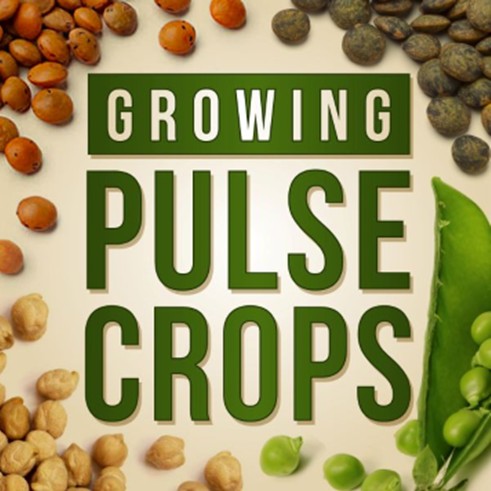
Feeding for the Finish: Key Nutrient Milestones in Corn Growth
As you're reading this, you're probably wrapping up the last passes of your corn weed control program and starting to shift gears into thinking about nutrient management. It’s the right time—because the decisions you make now will directly impact yield potential.
Let’s assume you’ve already made your primary fertility applications— nitrogen, phosphorus, potassium, sulfur, and maybe some micros— with guidance from a solid soil test. If not... well, how do you know where you’re starting from or where you’re going? Flying blind without a soil test isn’t a strategy, it’s a guess. But let’s move forward assuming you’ve done the basics right.
V5: The First Yield Milestone—Ear Girth
The first major yield-determining event in corn occurs around the V5 growth stage (ranging from V4 to V6 depending on hybrid). This is when the ear girth is determined—how many rows of kernels your corn ear will have. At this stage, the crop should have all the "groceries" it needs to grow strong: N, P, K, S, and others should already be in place from your spring or fall applications.This is also the stage when you’ll see some Midwest growers applying nitrogen. Not necessarily to feed the plant today, but to ensure it has what it needs going into the next major growth phase—especially on sandy soils or after heavy rainfall events that can lead to leaching.
Another question that often comes up at V5: “What else can I do to push yield?” One solid answer is zinc. Corn is very responsive to foliar zinc early on. But—this only pays if you’ve already nailed your macro- nutrient strategy. If you’re short on N, P, or K, don’t expect zinc to bail you out. Want to know if you're short? Tissue sampling is your best friend here.
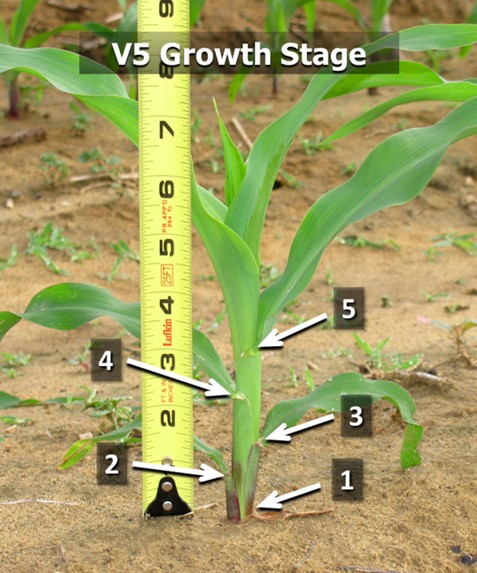
Five fully emerged leaves with leaf collars. Count the first leaf even if it is no longer attached or dead. Usually 10-14 inches tall. (Erick Larson, MSU)
V7–V10: The Grand Growth Stage
Next comes what many call the “grand growth stage,” starting around V7–V8 and continuing until tassel. Corn is growing fast—several inches a day—and its nutrient demand skyrockets.In the middle of this stage, around V10, the plant determines how long the ear will be—how many kernels per row. This is the second major yield pillar. For those of you with pivots and nurse tanks, this is a golden opportunity to apply more nitrogen. It’s not about overdoing it— it’s about making sure the plant has what it needs when it needs it.
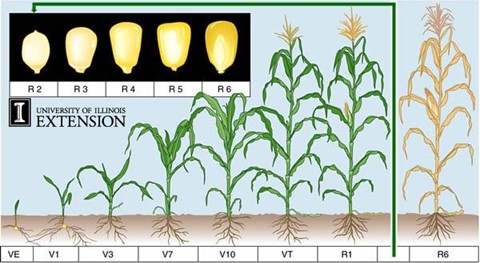
After V6 lower 2-3 leaves may be decomposed. To stage the crop count leaf collars. You can also use the NDAWN Corn GDD Tool.
Pre-Tassel: Don’t Forget Boron
As you prepare for tassel, it’s a good time to think about one more key micronutrient: boron. Corn is especially responsive to boron during its reproductive stages. Why? Because boron plays a critical role in pollen tube formation, every silk on an ear of corn is essentially a pollen tube. To get full pollination and complete kernel set, you need strong, viable pollen.Applying boron just before tassel ensures that it’s available in the plant when it's needed most to support pollination success.
Tassel to Dent: Keep Feeding
You’ve passed the two big yield-determining stages—ear girth and ear length—but you’re not done yet. Corn’s appetite for nitrogen doesn’t drop off after tassel. In fact, continued uptake supports kernel depth and weight, which are huge factors in final yield.This is where spoon-feeding nitrogen through your pivot can pay dividends. You don’t need a massive rate in one shot—just keep the plant fed and happy during this period to drive kernel size and weight.
Wrapping It Up
Understanding these key growth milestones—V5 (ear girth), V10 (ear length), and the tassel-to-dent phase (kernel size)—helps you time your nutrient applications for maximum yield impact.Here’s your takeaway:
- Soil test first. You can’t manage what you don’t measure.
- Tissue sample to monitor what the plant is saying mid-season.
- Zinc at V5 if macros are in place.
- Add N at V10 if possible, especially on irrigated or sandy ground.
- Apply boron pre-tassel to support pollination success.
- Spoon-feed N through tassel to dent for kernel weight.
Put simply—feed the crop when it needs it most, and it’ll pay you back in bushels.
Kyle Okke, CCA
Agile Agronomy LLC & Agronomists Happy Hour Podcast
Fairview Agronomy Update
Soybeans
If you’ve noticed purple soybean fields in the area, there's no need for concern. This phenomenon is typically caused by cooler temperatures and a source-sink imbalance within the plant. In these conditions, the soybean plant produces more carbohydrates (sugars) than it can utilize for growth and development. With limited storage capacity, excess sugars accumulate as anthocyanins in the stem tissue, resulting in the distinctive purple coloration.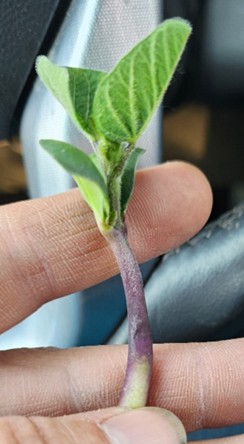
Early Season Foliar Disease in Wheat and Barley
Our extended cool spring, combined with persistent dew that lingers late into the day, has created ideal conditions for fungal foliar diseases. Many of these pathogens overwinter on crop residue and produce spores in wet conditions. Recent windy weather may havecontributed to the widespread distribution of spores across the region.
The best defense against tan spot and other foliar leaf spot diseases is an integrated management approach, which includes:
- Crop rotation
- Variety selection
- Managing crop residue
- Applying a fungicide early in the season
For more detailed information, refer to these guides from NDSU and MSU on fungal leaf spot diseases:
NDSU – Fungal Leaf Spot Diseases of Wheat (PP1249)
MSU—Fungal, Bacterial and Physiological Diseases of Cereals
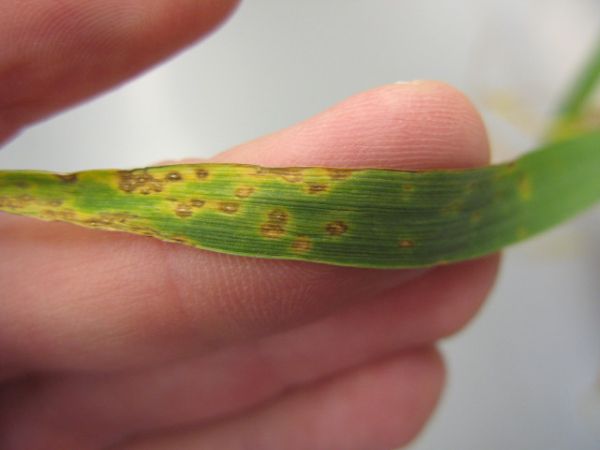
Tan spot symptoms— Dr. Mary Burrows
Weed of the Week: Russian Thistle
The weed of the week is Russian thistle, and this narrow-leafed rascal has been carpeting small grain fields in our area. This weed is especially troublesome due to its narrow leaves coated with a waxy cuticle, which provides an effective defense against herbicides.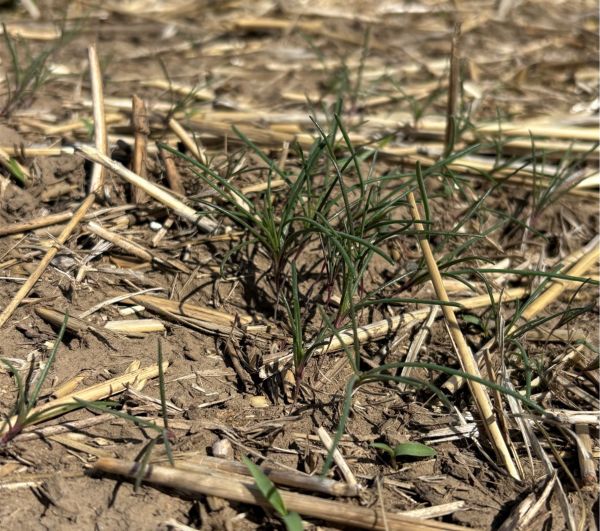
For best control:
- Apply herbicides at a minimum of 10 gallons per acre
- Use a high-quality adjuvant to improve spray coverage and herbicide uptake
- Rotate herbicide modes of action and use tank mixes with multiple modes to prevent resistance development
To learn more, see this resource from Montana State University: MSU Extension – Russian Thistle Management (MT201816AG)
Julia Seiller, Fairview Location Agronomist
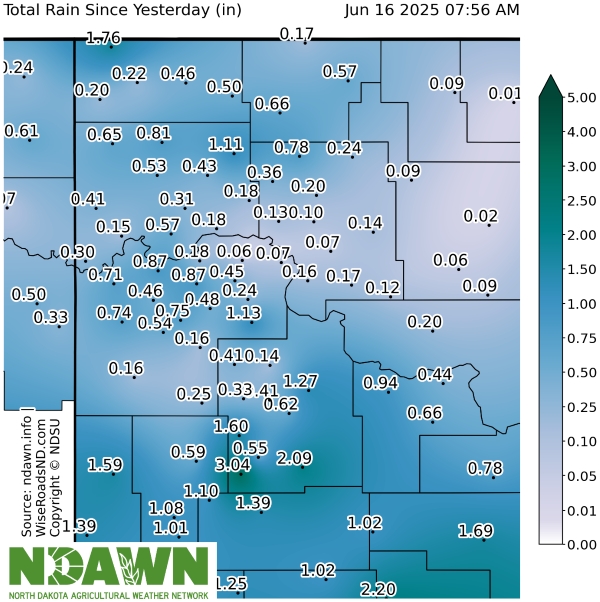

Predicted growth stages according to the NDAWN Growing Degree Day models for wheat and canola. Rainfall is from the Williston NDAWN station.